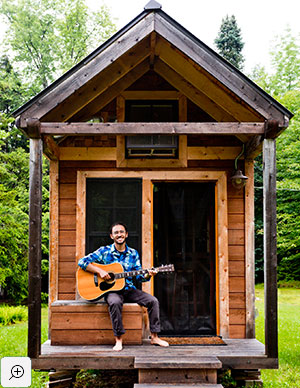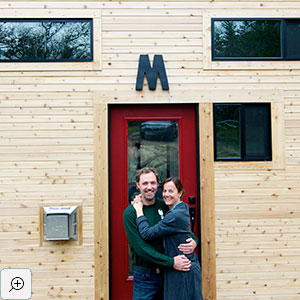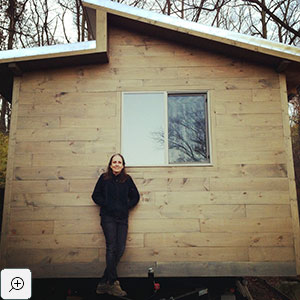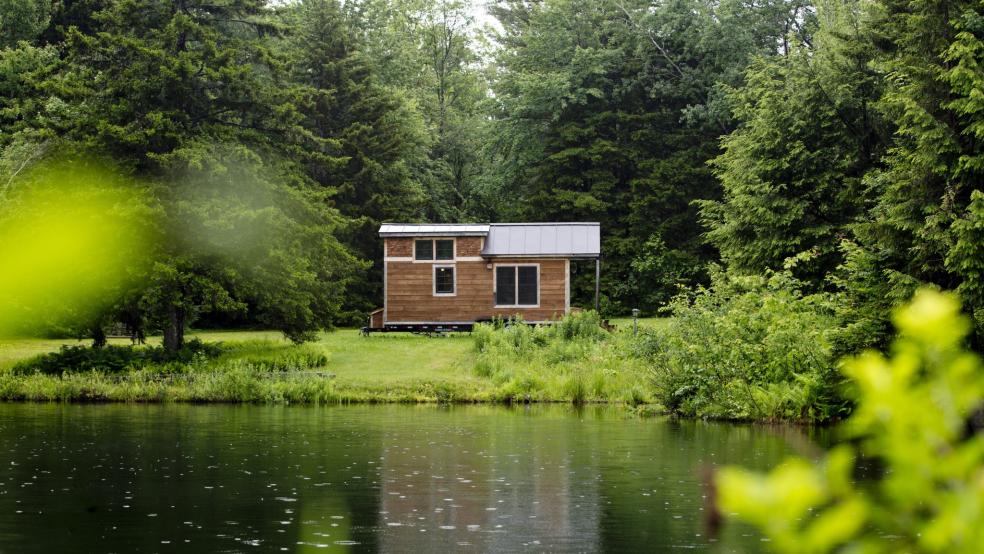Ethan Waldman wanted to cut his living expenses. He already shared a two-bedroom rental house with a friend, but Waldman, 31, suspected he could save more living alone in an untraditional space — a tiny home.
“I saw it as a way to reduce what I spent on rent, a way to own a home for not too much money and a home that could be moved,” says Waldman, who blogs about his experience.
Four years later, Waldman now splits his time between his 220-square-foot home in Morristown, Vermont, and his fiancée’s condo in Burlington. He estimates that he saves about $1,250 to $1,300 a month through drastically reduced utility costs and not paying rent.
Slideshow: Click here to take a closer look at these 3 tiny houses
Waldman is part of the so-called tiny home movement that has grown in popularity if not actual numbers. There aren’t many statistics tracking the number of tiny home dwellers and U.S. Census figures show that the median size of new home has grown more than 10 percent compared to a decade ago and is more than 50 percent larger than in 1985.
But tiny home living has captured the mainstream consciousness thanks to popular TV shows — including Tiny Home Nation, Tiny Home Builders, and Tiny Home, Big Living — blogs and conferences, all dedicated to this unconventional kind of abode.
Many would-be tiny home owners are attracted to the environmental benefits of a smaller footprint, the pared-down lifestyle that goes against American consumerism, and — not least — the financial savings that come with living small.
“I don’t feel the financial dread I used to, thinking about how I have a 30-year mortgage and will be paying this into our 70s,” says Jody Brady of the Simply Enough blog, who now lives in a 12-foot by 24-foot home in the Blue Ridge Mountains in Virginia with her husband and owns the house outright. As for her previous home, a 3,500-square-foot house in Arlington, Virginia? “That house owned us,” Brady, 59, says.
The cost of building a tiny home

Click to see more of the Waldman House
Despite other savings, constructing a tiny home requires a significant upfront financial commitment. For instance, Waldman’s house cost $30,000 in materials and $13,000 in labor; he outsourced the cabinets, roofing and insulation but did the rest himself. He paid for most of it through savings, some of which he gathered during the construction process.
Related: 10 Tiny but Luxurious Homes
Brady paid for her tiny house from proceeds from her previous home’s sale, which sold for $850,000, and the sale of many of her possessions. All in, the house cost $40,000 to build, entirely for materials since she and her husband built the house.
While the Waldman and Brady houses were cheaper than a larger home — the average cost of an average home to a homebuilder is $289,415 — the price per square foot is higher. Waldman’s home cost $150 per square foot (considering materials and labor) and Brady’s cost $139 per square foot, compared to $104 per square foot for an average new home, according to the NAHB (using only construction costs).
But Andrew and Gabriella Morrison of Ashland, Oregon, were able to construct their tiny home for about half that at $55 per square foot. That included their 207-square-foot home with a 110-square-foot loft, plus a 160-square-foot sleeping cabin for their son and a 120-square-foot one for their daughter.
“It took us four months to build it,” says Gabriella, who runs TinyHouseBuild with her husband. “It was just Andrew doing all the work. We never hired out. Our total costs including cabinetry and appliances was $33,000.”
Don’t forget the land
It’s not the cost of building the house that tiny home builders have to consider. There’s also the expense of the land, which is typically wrapped up into the total cost of a traditional home. Waldman rents the land his home sits on, using a work-rent trade. He provides web design for the land owner instead of paying rent.
Related: The Best Home Improvement Projects for Your Money
The Bradys live on a plot that is owned by a friend, who they pay about $225 to $250 a month for the land, storage space and use of her washing machine and dryer.

Click to see more of the Morrison House
The Morrisons, however, own their land and paid $65,000 for the 5.5-acre property, which is cheap compared to other plots of similar size in their area, largely due to a lack of a septic system. “If it had an approved septic system, it would have cost three times as much,” says Andrew.
They ponied up an additional $18,000 to create an acceptable septic system, which turned out to be less expensive than buying a septic-approved lot. But that’s still a lot of dough, considering the Morrison’s shelled out $116,000 in cash for land, construction and a septic system. That’s more than half of the median U.S. home price.
Mortgage savings
Despite the substantial upfront money involved — which often is enough for a 20-percent down payment on a regular home — these tiny home owners save big on not borrowing money, in both the short term and long term.
First, there is the savings every month from not making a mortgage payment. For instance, the monthly mortgage payment on a $160,000 loan is $764 (30-year fixed at 4 percent). That’s a big chunk of change every month. Then there’s the interest that you never get back, to tune of $115,000 over the 30 years on the same home loan.
“About 27 percent of your salary goes to housing, which equates to more than 10 hours of a 40-hour workweek,” says Andrew Morrison. “How many hours of your life do you want to spend working for your house?”
Energy savings
Smaller homes in general come with lower utility costs, so a tiny home offers even bigger savings. Waldman spends $100 to $150 a month on average for heating and electricity. His heating system uses propane.
Both the Morrisons and Bradys invested in solar power for their tiny homes, which required more money up front. The Morrison’s spent $8,000 after tax credits for a solar system. They spend about $75 a month on propane for heating water and cooking. They also have a gas generator for winter that costs about $50 a month for three months.

Click to see more of the Brady House
The Bradys shelled out $5,000 on a solar generator that supplies most of the home’s energy. They run the hot water heater, microwave and refrigerator on grid electricity, which costs about $25 a month (including water), or $300 a year. “At our house in Arlington, we paid $3,000 for electric, gas and water for the year,” Brady says. They also splurged on a wood stove for the winter months for $4,500.
Other costs
The other costs of furnishing a tiny home run the gamut. The Brady’s wanted an alcohol-burning stovetop and oven, which cost $1,500. An electric one would have been much cheaper at $300, but it would waste more energy.
In general, appliances designed for small efficiency apartments can be relatively inexpensive, while those made for boats and RVs are costlier. Waldman’s water heater, which is designed for a boat and smaller than other off-the-shelf ones, cost $1,500. Generic ones typically run between $300 and $800.
A special composting toilet can go for anywhere between $800 and $2,000, which is a lot more than a run-of-the-mill porcelain one for $100. Waldman opted to build an economical, bucket-style sawdust toilet instead. But his shower is lined with pricey copper roofing shingles that add some style.
“In a tiny home, you’re able to use expensive, quality material that you may not have been able to use in a bigger home,” he says. “But because of the scale of the house, these rich materials were affordable.”





